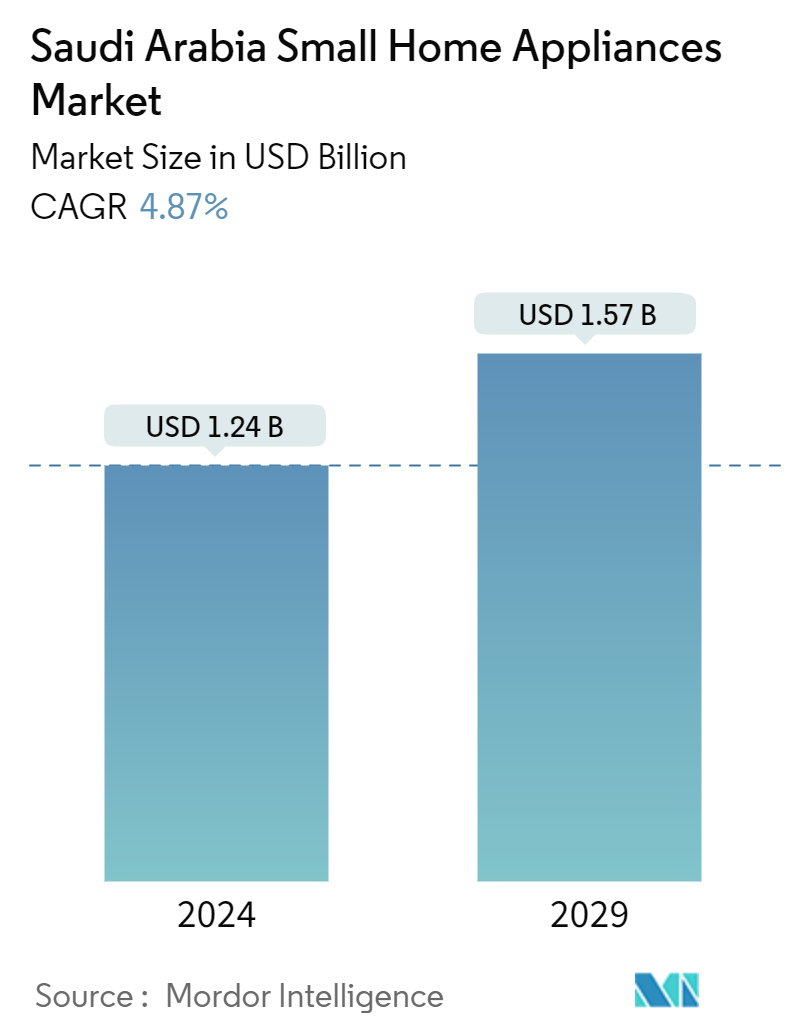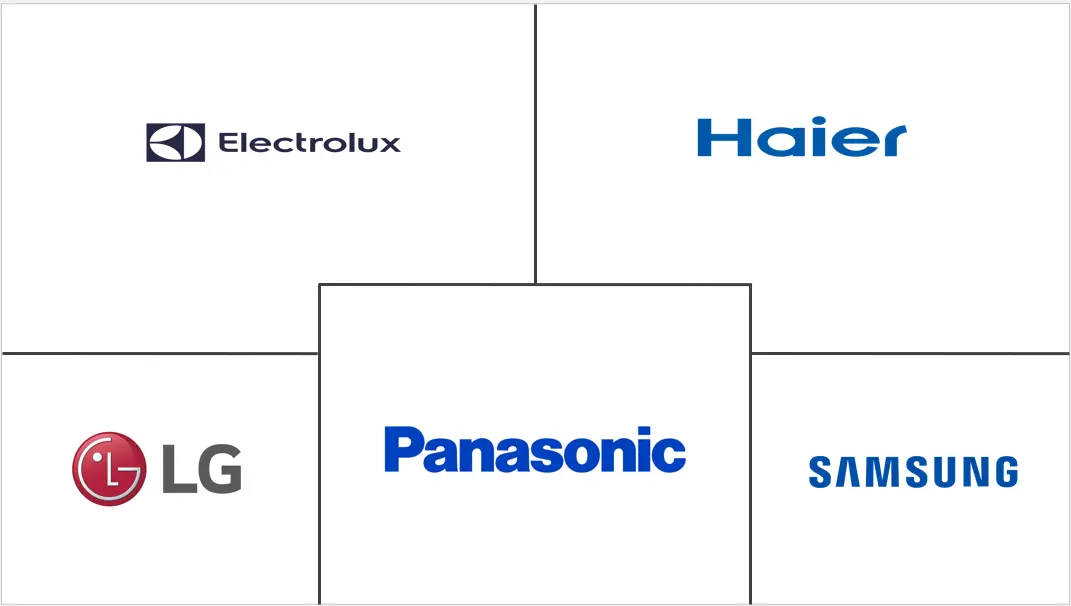Market Size of Saudi Arabia Small Home Appliances Industry

| Study Period | 2020 - 2029 |
| Base Year For Estimation | 2023 |
| Market Size (2024) | USD 1.24 Billion |
| Market Size (2029) | USD 1.57 Billion |
| CAGR (2024 - 2029) | 4.87 % |
| Market Concentration | Medium |
Major Players
*Disclaimer: Major Players sorted in no particular order |
Saudi Arabia Small Home Appliances Market Analysis
The Saudi Arabia Small Home Appliances Market size is estimated at USD 1.24 billion in 2024, and is expected to reach USD 1.57 billion by 2029, growing at a CAGR of 4.87% during the forecast period (2024-2029).
- Saudi Arabia's small home appliances market is expected to rise significantly during the projected period. The increase can be ascribed to technical developments and increased urbanization activities. Furthermore, Saudi Arabia's small home appliances market is predicted to be driven by a rise in the housing sector and changes in consumer lifestyles. The growing consumer preference for energy-efficient appliances due to increased environmental consciousness and the desire for comfort in household tasks adds to the growth of Saudi Arabia's small home appliances market.
- Rapid urbanization is the primary driving force behind the country's home appliance industry growth. Replacement sales are gaining pace throughout the world, with the clear majority of people wanting to replace their existing appliances with smarter, more inventive, and smaller appliances. Quick growth in disposable incomes has resulted in mid to high-income consumers selecting premium, sophisticated, and higher-priced models, hence driving home appliance value sales in the country.
Saudi Arabia Small Home Appliances Industry Segmentation
A small home appliance, a small electric appliance or minor appliance, or a small appliance, small domestic or small electric, is a portable or semi-portable machine, generally used on table-tops, counter-tops, or other platforms, to accomplish a household task.
The Saudi Arabia small home appliances market is segmented by product type, which includes coffee makers, food processors, grills and roasters, vacuum cleaners, and other small home appliances, and by distribution channel, which includes multi-branded stores, specialty stores, online stores, other distribution channels.
The report offers market size and forecasts for the Saudi Arabia small home appliances market in terms of revenue (USD) for all the above segments.
| By Product | |
| Coffee Makers | |
| Food Processors | |
| Grills and Roasters | |
| Vacuum Cleaners | |
| Other Small Appliances |
| By Distribution Channel | |
| Multi Branded Stores | |
| Specialty Stores | |
| Online Stores | |
| Other Distribution Channels |
Saudi Arabia Small Home Appliances Market Size Summary
The Saudi Arabia small home appliances market is poised for significant growth over the forecast period, driven by technological advancements and increased urbanization. The market's expansion is further supported by a burgeoning housing sector and evolving consumer lifestyles, which emphasize the need for energy-efficient and convenient appliances. The trend towards smart homes, where devices can be controlled remotely, is gaining traction, contributing to the market's development. As broadband and internet infrastructure improve, consumers are increasingly opting for wireless and technologically advanced appliances, enhancing security and comfort in their homes. This shift is also reflected in the growing preference for premium and sophisticated models among mid to high-income consumers, boosting the overall value sales of home appliances in the country.
The demand for small home appliances in Saudi Arabia is influenced by several factors, including the desire for value-for-money products, reasonable warranty periods, and reputable brands. There is a noticeable shift towards energy-efficient models, driven by a commitment to energy conservation and sustainability. The market is characterized by fragmentation, with numerous players, including multinational companies and smaller businesses, competing for market share. Leading companies like Haier, Whirlpool, Electrolux, LG, Godrej, Panasonic, and Samsung are at the forefront, leveraging technological innovations to introduce user-friendly and innovative appliances. Partnerships and collaborations, such as those between Hisense and the United Matbouli Group, and Panasonic with Ahmed Abdulwahed Trading Co, are further enhancing market presence and expanding operations within the Kingdom.
Saudi Arabia Small Home Appliances Market Size - Table of Contents
-
1. MARKET INSIGHTS AND DYNAMICS
-
1.1 Market Overview
-
1.2 Market Drivers
-
1.2.1 Increasing Urbanization is Driving the Market
-
-
1.3 Market Restraints
-
1.3.1 High Competition in the Industry is Restraining the Market
-
-
1.4 Market Opportunities
-
1.4.1 Demand for Smart and Energy-Efficient Appliances is Creating an Opportunity
-
-
1.5 Value Chain / Supply Chain Analysis
-
1.6 Porter's Five Forces Analysis
-
1.6.1 Threat of New Entrants
-
1.6.2 Bargaining Power of Buyers/Consumers
-
1.6.3 Bargaining Power of Suppliers
-
1.6.4 Threat of Substitute Products
-
1.6.5 Intensity of Competitive Rivalry
-
-
1.7 Insights on Technological Innovations in the Small Home Appliance Industry
-
1.8 Impact of COVID-19 on the Market
-
-
2. MARKET SEGMENTATION
-
2.1 By Product
-
2.1.1 Coffee Makers
-
2.1.2 Food Processors
-
2.1.3 Grills and Roasters
-
2.1.4 Vacuum Cleaners
-
2.1.5 Other Small Appliances
-
-
2.2 By Distribution Channel
-
2.2.1 Multi Branded Stores
-
2.2.2 Specialty Stores
-
2.2.3 Online Stores
-
2.2.4 Other Distribution Channels
-
-
Saudi Arabia Small Home Appliances Market Size FAQs
How big is the Saudi Arabia Small Home Appliances Market?
The Saudi Arabia Small Home Appliances Market size is expected to reach USD 1.24 billion in 2024 and grow at a CAGR of 4.87% to reach USD 1.57 billion by 2029.
What is the current Saudi Arabia Small Home Appliances Market size?
In 2024, the Saudi Arabia Small Home Appliances Market size is expected to reach USD 1.24 billion.

